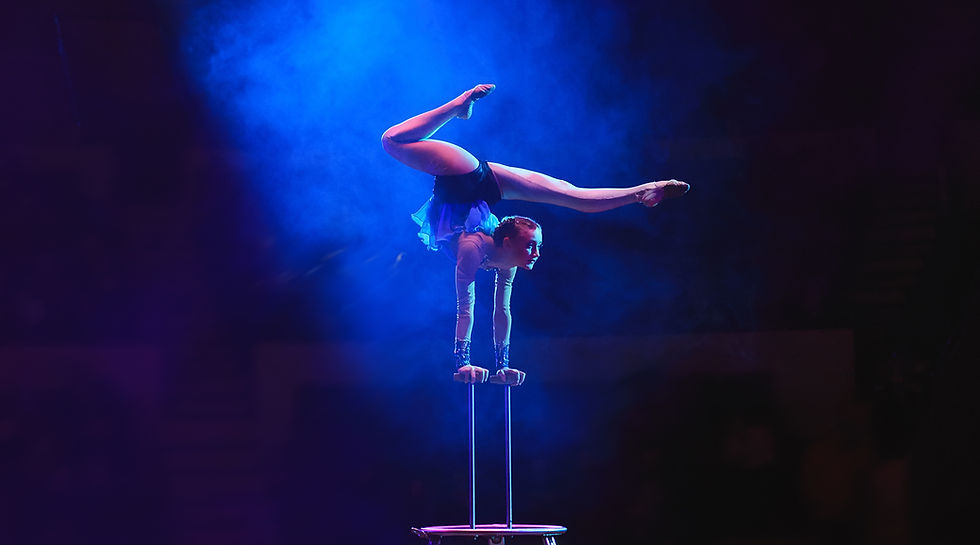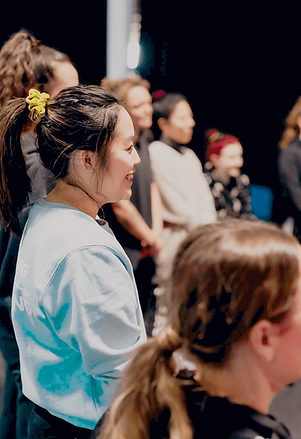Upside Down Strength with Judit: The Journey to Mastering Hand Balancing
- Clarice Liu
- Mar 27
- 4 min read
Updated: Apr 26
Podcast interview with Judit
Have you ever looked at someone effortlessly balancing upside down and thought, "That's just impossible for me"? You're not alone! On this episode of the Grow Through Movement podcast, we interview Judit, a London-based hand balancer, performer and coach. She shares her inspiring journey from a curious 12-year-old in her living room to a professional in the captivating world of circus arts. Her story is a testament to passion, perseverance, and the power of community.
Judit's Journey
The Start of Her Fascination With Circus Arts
Her fascination with handstands ignited after witnessing a mesmerizing handstand contortion act at Cirque du Soleil. Back in Hungary, access to formal circus training was limited, often reserved for those born into circus families.
However, a move to London at 15 opened up a world of possibilities.

Contortion to...Hand Balancing!
Initially drawn to contortion, Judit found a natural talent for flexibility. But the wisdom of others nudged her towards incorporating more strength training, specifically handstands, to create a more balanced and resilient practice. This led her to take classes at the London School of Hand Balancing- one of the renowned hand-balancing schools in London.
The Pursuit of Mastery: Navigating Circus School and Finding Community
Driven to hone her skills, Judit auditioned for circus schools, facing initial rejections before attending a school in the Netherlands. While she gained her foundation diploma, the school's structure didn't quite align with the consistent dedication required for hand balancing.
Returning to the UK and navigating the challenges of solo training during lockdown, Judit realized the vital role of community and structured learning. This led her back to audition for the London school, where she successfully completed her degree program.
The Strength vs. Flexibility Myth: What It Really Takes
"You need immense strength to even begin a handstand"- this is common misconception many have!
Judit debunks this myth:
Often strong-looking gym-goers struggle in handstand classes due to stiffness.
While some shoulder strength is necessary and will develop with practice, flexibility, particularly in the shoulders, plays a significant role.
Greater shoulder mobility allows for better alignment and less reliance on brute strength, leading to improved stamina.
Taming the "Banana Handstand" and Finding Your Line
If you have trained handstands before, you are certainly no stranger to the infamous yet common "banana handstand": where an excessive arch in the lower back can hinder balance and control.
Judit explains the importance of building body awareness through floor and wall drills.
These supported positions help you understand the "hollow body" position, a crucial element for a stable handstand, making it easier to translate that awareness when upside down.
The Anatomy of an Upside-Down World
When you consider what physical capabilities are required for a handstand, we need to think about elements including:
wrist mobility,
full shoulder range of motion,
impact of hamstring flexibility on the kick-up.
And of course there is more!
Judit emphasises the crucial role of external rotation of the shoulders for a strong and stable lock, a common area where beginners often go into internal rotation, which can feel initially spacious but is ultimately less supportive and potentially harmful.
Avoiding the Pitfalls: Common Mistakes for Handstand Beginners
A key piece of advice for those starting their handstand journey: avoid shortcuts and trust the foundations.
Skipping drills and trying to rush the process often leads to wasted time. Finding an experienced coach can provide invaluable guidance and prevent the frustration of repetitive, ineffective practice.
Patience and the Upside-Down Brain
Patience is paramount. Learning to balance on your hands is akin to a baby learning to walk – it takes time, wobbles are inevitable, and your body needs to adapt to a completely new orientation. Your brain also needs time to adjust to this upside-down perspective.
Conquering the Fear of Falling
The fear of falling is a significant hurdle for many beginners.
Some practical tips to try:
building a minimal level of shoulder strength, practicing moving your hands to adjust your balance (even against a wall)
utilizing cartwheels to gain confidence with hand placement.
The invaluable support of a teacher or spotter can also significantly ease this transition, providing a safety net and helping you understand proper alignment.
Key Tips for the Solo Handstand Explorer
For those training independently, Judit offers these crucial starting points:
Proper Shoulder Warm-up: Emphasising shoulder dislocations (= shoulder flosses, not an actual dislocation!) with a stick or elastic to improve range of motion.
Plank Practice: Focusing on a straight line, pushing tall through the shoulders, engaging the core and glutes.
Wall Work: Practicing kick-ups and hollow body holds against the wall, ensuring only your heels touch.
L-Holds: If kicking to the wall isn't yet accessible, use a couch or chair to elevate your feet and walk your hands in, building strength in the L-position.
Growth Through Movement: A Personal Reflection
When asked what "growth through movement" means to her, Judit shares a heartfelt sentiment.
For her, movement is the foundation of her life, encompassing her performing, coaching, and training. It's the driving force behind all the good in her world.
Connect with Judit
Want to learn more from Judith? You can find her and her incredible work on Instagram at @Judit.Circus.
Summary
This episode of Grow Through Movement is packed with valuable insights for anyone curious about handstands, regardless of their current level. Judit's journey and expertise offer a refreshing perspective on the blend of strength and flexibility, the importance of mindful practice, and the power of community in achieving your movement goals. So, whether you dream of balancing upside down or simply appreciate the beauty and skill involved, be sure to listen to the full episode and share it with your fellow movement enthusiasts!

Our blogs and articles are not designed to replace medical advice. If you have an injury, we recommend seeing a qualified health professional. We offer both in-person assessments and online consultations!



.png)





Comments